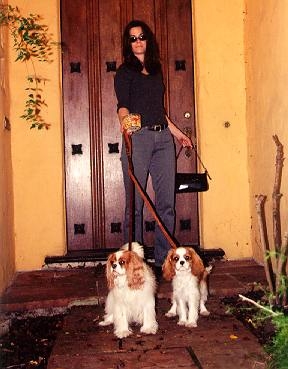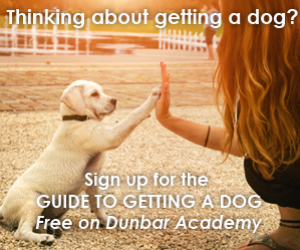Training on the Dog Walk

As soon as it is safe for your puppy to go out, take him on walks — lots of them. There is no better overall socialization exercise and no better overall training exercise. As an added benefit, dog walks are good for your health, heart, and soul. Walk that dog! Tie a pink bow to his collar and see how many smiles you get and how many new friends you make. Doggy socialization is good for your social life.
Housetraining on Walks
If you do not have a private yard or garden, make sure your dog urinates and defecates before you begin your walk. Thus, the walk becomes a reward for doing the right thing in the right place at the right time. Otherwise, when you terminate an enjoyable walk after your dog has done her duty, you end up punishing her for eliminating. Your dog might then start delaying elimination to prolong his walks.
Put your puppy on-leash, leave the house, and then stand still and let the pup circle and sniff. Give her four or five minutes. If she doesn't perform, go back indoors and try again later. Keep your pup in her short-term confinement area for the interim. If your puppy does go within the allotted time, praise her profusely, reward her with a dog treat, say, "Walkies," and off you go. You'll find a simple "no feces = no walk" policy quickly produces a speedy defecator.
There are additional benefits to teaching your dog to eliminate prior to a walk. Clearing up the mess and depositing it in your own trash is much more convenient than a mid-walk cleanup. Walking an empty dog empty-handed is also generally more relaxing than walking a dog and lugging around a bag of dog doo doo.
Socializing on Walks
Take a few time-outs on each walk. Do not rush your young dog through the environment. Give your dog ample opportunity to relax and watch the world go by. A stuffed Kong will help her settle down quickly and calmly each time you stop.
Never take your dog's even temperament for granted. The great outdoors can be a scary place, and there will be the occasional surprise to spook your pooch. The best approach is to prevent these problems. Handfeeding your dog her dinner on walks helps her form positive associations with people, other dogs, and traffic. Offer your dog a piece of kibble every time a car, big truck, or noisy motorcycle goes by. Offer your dog a couple of pieces of kibble every time another dog or person passes. Praise your dog and offer a treat whenever she greets another dog or person in a friendly fashion. Praise your dog and offer three tasty treats whenever a child approaches. And when a child whizzes by on a skateboard or dirt bike, handfeed her the whole bag of food.
Should someone wish to meet your dog, first show them how to use kibble to lure/reward her to come and sit. Ask the stranger to offer the kibble only after your dog sits to say hello. From the outset, teach your dog to always sit when meeting and greeting people.
Training on Walks
When your dog is five months old, puppyhood is over, and you will begin to realize that the canine weight-pulling record approximates ten thousand pounds. Dogs pull on-leash for many reasons. The view is always better for the lead dog. A tight leash provides the dog a "telegraph wire" that communicates the owner's intentions, thus affording the dog the luxury of looking around and otherwise checking out the action. Pulling while on-leash appears to be intrinsically enjoyable for dogs. And we let them do it. Each second the leash is tight, each pulling moment is hugely reinforced by each step the dog takes, forging ahead to investigate the ever-exciting, ever-changing olfactory environment. Here are a few dos and don'ts for teaching your dog to walk calmly on-leash:
DO practice leash walking around your house and yard from the very beginning, and take your puppy for walks in public as soon as he is old enough.
DON'T wait until your dog reaches adolescence before trying to teach him to walk on-leash in public, unless you wish to provide amusement for onlookers.
DO alternate short periods of 15 to 30 seconds when your dog walks by your side, with longer periods of a minute or so when your dog is allowed to range and sniff at the end of the leash. This motivates your dog to walk by your side, as walking side-by-side is regularly reinforced by permission to range and sniff.
DON'T expect your adolescent (or adult) dog to endlessly heel. He will learn that heeling is mutually exclusive to ranging and sniffing. He won't want to heel and will grow to resent training and the trainer (you) for spoiling his fun.
DO consider training your dog to pull on-leash. Thus, instead of being a problem, pulling on-leash can be the solution, an effective reward to reinforce calmly walking by your side. Alternating slack-leash walking and pulling on-leash is enthusiastically endorsed by my Malamutes. Two paws up! Also, on-command leash-pulling is wonderful for ascending steep hills, pulling sleds, soapbox cars, and skateboards.
DON'T allow your dog to decide when to pull on leash. Employ red light/green light training. When your dog tightens the leash, immediately stop, stand still, and wait. Once he slackens the leash, or better yet, once he sits, proceed with the walk.
Red Light/Green Light
The good old dog walk has to be one of the dog's biggest rewards, second only to a romp in the park. Many dogs go quite crazy at the prospect of a walk, and of course, the walk only reinforces his craziness. Moreover, dogs pull on-leash with increasing vigor with every step you take, and, of course, each step you take reinforces the dog's pulling. Luckily, there's a better way. The walk can reinforce your dog's good manners.
Before going on a walk, practice leaving the house in a mannerly fashion. Say "Walky, Walky, Walkies!" and waggle the dog's leash in front of his nose. Most dogs will go ballistic. Stand still and wait for your dog to calm down and sit. With his walk stalled before starting, your dog will suspect you want him to do something, but as yet he isn't sure what. He will likely offer many creative suggestions, maybe his entire behavior repertoire. Your dog may frantically bark, beg, jump up, lie down, roll over, paw you, and circle you. Ignore everything your dog does until he sits. It doesn't matter how long it takes; your dog will sit eventually. When he does, say, "Good dog," and snap on his leash. When you snap on his leash, your dog will likely reactivate. So stand still and wait for him to sit again. When he does, say, "Good dog," take one step toward the door, stand still, and then wait for him to sit once more. Head toward the door one step at a time and wait for your dog to sit after each step. Have your dog sit before you open the door and have him sit immediately after going through the door. Then come back inside, take off the dog's leash, sit down, and repeat the above procedure.
You'll find that the time it takes for your dog to sit progressively decreases as the exercise proceeds. You'll also notice your dog becomes calmer each time you leave the house. By the third or fourth time you leave, your dog will walk calmly and sit promptly.
Don't prompt your dog to sit. Don't give him any clues. Let your dog work it out for himself. Your dog is learning even when he presents a series of unwanted behaviors. He is learning what you don't want him to do. The longer you wait for your dog to sit, the better he learns which behaviors are unwanted. When your dog sits and receives praise and a reward, he is learning what you want him to do.
Dogs love this game. After playing the game for a very short time, your dog learns which green-light behaviors (sitting) get you to proceed and which red-light behaviors (everything else) cause you to stand still.
When your dog can leave the house in a mannerly fashion, it is time to go for a real walk. Put your dog's dinner kibble in a bag, for today he will dine on the walk. Hold a piece of kibble in your hand, stand still, and wait for your dog to sit. When he does, say, "Good dog," and offer the kibble. Then take a giant step forwards, stand still, and wait for your dog to sit again. As soon as you step forward, likely your dog will explode with energy. Stand still and wait. Eventually your dog will sit again. Say, "Good dog," offer the kibble, and take another giant step forward. As you repeat this procedure over and over, you'll notice your dog sits progressively more quickly each time you stand still. After just a few repetitions your dog will begin to sit immediately each time you stop. Now take two giant steps before your stop. Then try three steps and stop, and then five, eight, ten, twenty, and so on. By now you will have discovered that your dog walks calmly and attentively by your side and sits immediately and automatically each time you stop. You will have taught him all this in just one session, and the only words you said were "Good dog."
Sit and Settle Down
Have numerous short training interludes during the walk. Stop for a short training interlude every twenty-five yards or so. For example, each time you stop, say, "Sit," and as soon as your dog sits, say, "Let's go," and start walking again. Thus, every time you stop, resuming the walk effectively rewards your dog for sitting.
Keep most training interludes shorter than five seconds, so as to reinforce quick sits and downs or short sequences of body-position changes, such as sit-down-sit-stand-down-stand. You may periodically reward your dog with kibble if you like, but this is hardly necessary, because resuming the walk is a much better treat for your dog. Occasionally insert longer training interludes to practice having your dog walk by your side for 15 to 30 seconds at a time or to reinforce two- or three-minute settle-downs. Offer a stuffed Kong for your dog's amusement and read a newspaper for yours.
The above training techniques will mold your dog's behavior and mend his manners in a single walk. By averaging seventy or so training sessions per mile, a single walk will troubleshoot virtually any training problem. For example, you may experience some difficulty getting your excited dog to pay attention and settle down the first few times you stop, but by the fourth or fifth time, it will be easy. After an enjoyable three-mile walk (with two hundred or so training interludes), your dog will be nothing less than brilliant.
The reason why this technique is extraordinarily successful is twofold:
1. Repeated training interludes force you to face your foremost fears and conquer them. The troubleshooting nature of these repetitive training interludes allows you to solve pressing training problems quickly. For example, your problem is not that your dog does not settle down; he does, but only eventually, only occasionally, and only of his own volition. You want your dog to settle down promptly and reliably upon request. Practice over and over in the above fashion, with many short training interludes during the walk. Your dog will comply more and more quickly with each trial. Eventually, he will learn to comply immediately.
2. Most owners train their dog only in one or two locations, such as the kitchen and training class, and they end up with a good kitchen-dog and a mannerly class-dog. But the dog still doesn't pay attention on walks and in parks. Presumably, the dog thinks that "Sit" only means sit in the kitchen and in class, because they are the only two places where he has been trained. With seventy or so training interludes per mile, however, every single practice session is in a different setting with different distractions — on quiet streets and busy sidewalks, leafy trails and open fields, near schools, and in park playgrounds. Thus, your dog learns to heed your instructions and quickly and happily comply no matter where he is, what he is doing, and what is going on. Your dog generalizes the "Sit" command to mean sit everywhere and at any time.
If you train your dog on every walk, you will soon have a puppy that will sit quickly and settle down promptly with a single request, no matter how excited or distracted he may be. Moreover, your dog settles down willingly and happily because he knows that being told to lie down is not the end of the world and not even the end of the walk. Your dog will have learned that "Settle Down," for example, is just a relaxing time-out with gentle praise before his exciting life as Walking Dog resumes.
With your now-mannerly dog, you'll find that it is quicker navigating country roads and suburban sidewalks than with your previously hyperactive hound. Now you can follow your intended itinerary without being pulled every which way but loose.
Adapted from AFTER You Get Your Puppy by Dr. Ian Dunbar




